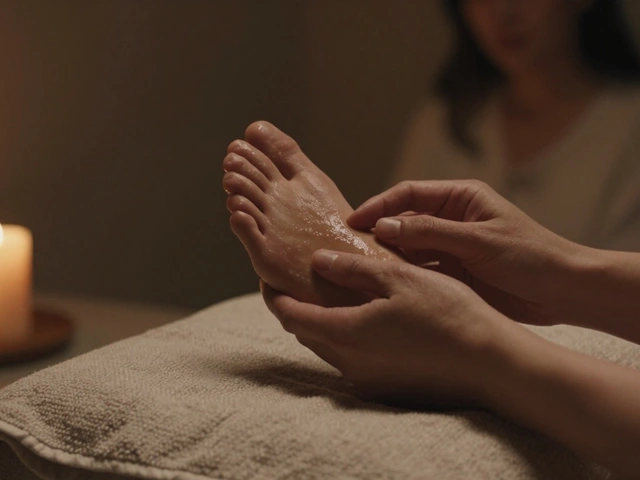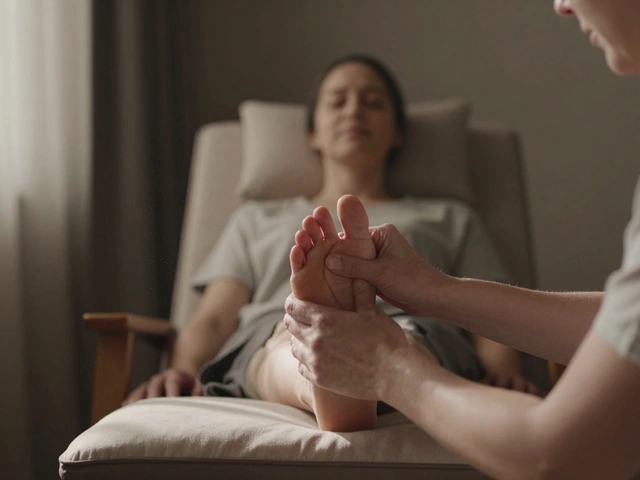Prenatal Massage Safety Checker
Is Prenatal Massage Safe for You?
This tool helps you determine if prenatal massage is safe based on your pregnancy conditions. For your health, always consult your healthcare provider before any treatment.
When you're pregnant, your body changes in ways you never expected. Aching back, swollen feet, trouble sleeping - these aren’t just inconveniences. They’re signals your body is working hard. Many expectant moms turn to prenatal massage not because it’s trendy, but because it actually helps. It’s not just about relaxation. It’s about managing real physical stress that comes with carrying a baby.
What Is Prenatal Massage?
Prenatal massage is a type of therapeutic bodywork designed specifically for pregnant women. It uses gentle pressure and specialized techniques to ease common pregnancy discomforts. Unlike regular massage, it avoids deep tissue work on the abdomen and lower back, and avoids certain pressure points that could trigger contractions.
The therapist will position you safely - usually on your side with supportive pillows - because lying flat on your back after the first trimester can compress the vena cava, a major vein that returns blood to the heart. This simple adjustment makes a big difference in comfort and safety.
Most prenatal massage therapists are trained in anatomy specific to pregnancy. They know which muscles to target, which areas to avoid, and how to adapt the session based on your stage of pregnancy. It’s not just a regular massage with a pregnancy pillow.
How Prenatal Massage Helps During Pregnancy
Research from the Journal of Bodywork and Movement Therapies in 2023 found that women who received weekly prenatal massage for eight weeks reported a 30% reduction in lower back pain and a 25% decrease in anxiety levels. These aren’t small improvements. They directly affect your ability to sleep, move, and even feel emotionally balanced.
- Reduces swelling: Gentle strokes toward the heart help move fluid out of swollen hands and feet. This is called lymphatic drainage, and it’s one of the most effective ways to ease edema without medication.
- Eases muscle tension: As your belly grows, your posture shifts. Your lower back, shoulders, and hips compensate. Massage loosens tight muscles in these areas, helping you stand and walk with less strain.
- Lowers cortisol: Stress hormones drop after massage. One study showed cortisol levels fell by an average of 31% after a 45-minute session. That means less irritability, better sleep, and a calmer nervous system.
- Improves circulation: Better blood flow means more oxygen and nutrients reach your baby. It also helps prevent varicose veins and reduces leg cramps.
- Supports emotional well-being: Many women report feeling more connected to their bodies after massage. It’s not just physical - it’s a moment of calm in a chaotic time.
These benefits aren’t theoretical. I’ve spoken with dozens of moms in Raleigh who started massage at 16 weeks and kept going until delivery. One told me, "I didn’t realize how much pain I was living with until it was gone."
When to Avoid Prenatal Massage
Not every pregnant woman should get a prenatal massage. There are important red flags.
- High-risk pregnancy: If you have preeclampsia, placenta previa, or are on bed rest, check with your OB first. Some clinics won’t even see you without a doctor’s note.
- First trimester complications: If you’ve had bleeding, severe nausea, or a history of miscarriage, many therapists wait until after 12 weeks. It’s not a rule - it’s a precaution.
- Blood clots or deep vein thrombosis: Massage can dislodge clots. If you’ve had a clot before or are on blood thinners, skip it unless cleared by your doctor.
- Fever or infection: Your immune system is already working hard. Adding stress through massage isn’t worth the risk.
Always tell your massage therapist about your full medical history. Even if something seems minor - like a recent bout of severe headaches or gestational diabetes - it matters.
What to Expect During Your First Session
Your first visit should feel more like a consultation than a treatment. A good prenatal massage therapist will spend 10-15 minutes asking questions:
- How far along are you?
- What discomforts are you dealing with?
- Have you had any complications?
- Do you have any allergies to oils or lotions?
- What kind of pressure do you prefer?
You’ll be positioned on your side with pillows under your belly, between your knees, and behind your back. Some clinics have special tables with cutouts for your belly, but side-lying is the gold standard. You won’t be asked to lie face down - ever.
The massage itself is slow, rhythmic, and focused. It’s not about kneading every muscle. It’s about releasing tension where it matters most: lower back, hips, calves, and shoulders. The therapist might use light circular motions on your feet to reduce swelling, or long strokes along your spine to ease tension.
Most sessions last 60 minutes. You can do 30 minutes if you’re new, but 60 gives your body time to truly relax.

Choosing the Right Therapist
Not every massage therapist knows how to work with pregnant women. Look for these credentials:
- Certified in prenatal massage: Ask if they’ve completed a 12+ hour prenatal training course. Many states require this for insurance billing.
- Experience with pregnant clients: A therapist who’s done 50+ prenatal sessions knows how to adjust for bumps, fatigue, and changing needs.
- Use of pregnancy-safe oils: Avoid essential oils like rosemary, clary sage, or juniper berry. Safe options include sweet almond, grapeseed, or coconut oil.
- Location: Choose a clean, quiet space. Avoid spas that also offer hot tubs, saunas, or steam rooms - those are unsafe during pregnancy.
Ask for referrals from your OB, midwife, or doula. If they recommend someone, that’s a strong sign. You can also check the American Massage Therapy Association directory - they list therapists with prenatal certification.
How Often Should You Get a Prenatal Massage?
There’s no one-size-fits-all schedule. But here’s what most women find works:
- First trimester (weeks 1-12): Optional. Only if you’re feeling good and have no complications. Once a month is fine.
- Second trimester (weeks 13-27): Ideal time. Most discomforts start showing up. Aim for every 3-4 weeks.
- Third trimester (weeks 28-40): Weekly sessions are common. As your body gets heavier, you need more frequent relief.
Some women stop at 38 weeks. Others go until delivery. If you’re due soon and your therapist is experienced, they can even do a short 30-minute session right before labor starts - it’s been shown to help with early labor pain.
Can You Do Prenatal Massage at Home?
You can’t fully replace a professional session, but you can support your body at home.
- Foot massage: Use a tennis ball under your feet while sitting. Roll slowly. It helps with swelling and plantar fasciitis.
- Partner massage: Ask your partner to use warm oil and long strokes on your back and legs. Avoid the lower back and abdomen.
- Self-massage tools: A foam roller on your upper back or a handheld massager on your calves can help. Don’t use vibration tools on your belly or pelvis.
Never try deep pressure or twisting motions. You’re not trying to "fix" anything - you’re just easing tension.

What It Costs and Insurance Coverage
In Raleigh, a 60-minute prenatal massage typically costs between $80 and $120. Some clinics offer package deals - four sessions for $300 is common.
Insurance rarely covers it outright. But some flexible spending accounts (FSAs) or health savings accounts (HSAs) do allow reimbursement if you have a doctor’s note. Ask your provider. Many women successfully get reimbursed with a simple note saying "therapeutic massage for pregnancy-related musculoskeletal pain."
Some doulas and birth centers offer discounted prenatal massage as part of their care packages. It’s worth asking.
Real Stories, Real Results
Emily, 34, had severe sciatica at 32 weeks. Walking more than 10 minutes was painful. After two weekly massages, she was able to walk her dog again. "I didn’t think I’d ever feel normal again," she said. "Now I’m planning my next session for after the baby comes."
Jamila, 29, struggled with anxiety during her second pregnancy. She started massage at 20 weeks and began journaling after each session. "It became my quiet time. I didn’t just feel better physically - I felt like I could breathe again."
These aren’t outliers. They’re common experiences.
Final Thoughts
Prenatal massage isn’t a luxury. It’s a tool for managing the physical and emotional toll of pregnancy. It doesn’t replace medical care. But it complements it in ways few other therapies can.
If you’re feeling overwhelmed by aches, stress, or fatigue - and you’re cleared by your provider - give it a try. One session might not change everything. But if you keep going, you might find that the weight you’re carrying - the baby, the stress, the discomfort - feels just a little lighter.
Is prenatal massage safe during the first trimester?
Yes, but many therapists wait until after 12 weeks as a precaution, especially if you’ve had bleeding, severe nausea, or a history of miscarriage. Always check with your doctor first. If you’re feeling well and have no complications, a gentle session can help with fatigue and nausea, but avoid deep pressure or strong essential oils.
Can prenatal massage induce labor?
No, not if done correctly. Licensed prenatal massage therapists avoid specific pressure points linked to labor induction, like SP6 (Sanyinjiao) on the inner ankle. These points are only targeted in late-term sessions by specialists trained in labor preparation - and even then, only with your consent and under medical guidance. Regular prenatal massage does not trigger contractions.
What should I wear during a prenatal massage?
You can undress to your comfort level. Most women keep their underwear on and are covered with a sheet or towel. The therapist will only uncover the area being worked on. You’ll never be exposed. If you’re uncomfortable, let them know - they’ve seen it all and will adjust immediately.
Can my partner join me during the session?
Most clinics allow partners to stay in the room, especially if you’re nervous or want them to learn techniques for home massage. They usually sit in a chair nearby. Some places even offer couple’s prenatal sessions where the partner gets a short massage too. Just ask ahead of time.
Are there any side effects of prenatal massage?
Side effects are rare and mild. Some women feel slightly lightheaded after the session due to increased circulation - drink water and rest for 10 minutes. Others feel emotionally tearful, which is normal - massage releases stored tension. If you feel sharp pain, dizziness, or contractions during the session, stop immediately and contact your provider.
Can I get a prenatal massage if I’m carrying twins?
Yes, but you’ll need a therapist experienced with high-risk pregnancies. Twin pregnancies often come with more intense back pain, swelling, and fatigue. Sessions may need to be shorter (45 minutes) and more frequent. Always get approval from your OB or perinatologist before starting.








